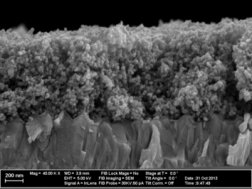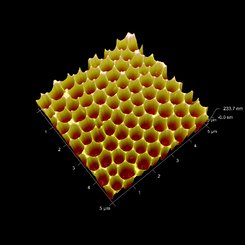 Hybrid solar cells are an emerging class of low-cost thin-film photovoltaics that combine materials and concepts from different other thin-film solar cells in order to overcome common loss mechanisms of thin-film devices like limited light absorption, inefficient charge separation and charge carrier recombination.
Hybrid solar cells are an emerging class of low-cost thin-film photovoltaics that combine materials and concepts from different other thin-film solar cells in order to overcome common loss mechanisms of thin-film devices like limited light absorption, inefficient charge separation and charge carrier recombination.
Hybrid solar cells combine high surface area n-type metal oxide nanostructures with organic p-type semiconductors, mostly conjugated polymers. In addition, the metal oxide is often coated with high extinction coefficient absorbers like organic dyes or inorganic compounds like CdSe, stibnite or lead halide perovskites.
Most commonly, the metal oxide electrodes are fabricated by sintering a film of nanoparticles. This strategy results in a high surface area and is synthetically easy to handle. However, the unordered nature of nanoparticle networks and the occurrence of many crystal grain boundaries limits the charge mobility through these structures and potentially increases charge recombination losses.
To adress this issue our group is involved in the development of low-cost self-assembly base synthesis routes for ordered metal oxide nanostructure arrays. Upscalable methods like anodic oxidation of metal films, electrodeposition from electrolyte solutions and hydrothermal growths are employed to grow nanopore, nanowire and nanotube arrays, mostly from TiO2 and ZnO. These structures are then implemented in hybrid photovoltaic devices in order to investigate the impact of the metal oxide geometry on fundamental processes in the solar cell.

|
SEM cross sectional view of a titania nanoparticle film as commonly used in hybrid solar cells. |
SEM top view of an anodized aluminum oxide film. |
|
SEM cross sectional view of a titania nanotube array on a conducting transparent glass substrate as readily usable for hybrid solar cells |
SEM cross sectional view of hydrothermally grown titania nanowires infiltrated with a conducting polymer. |
|
SEM top view of hydrothermally grown ZnO nanowires. |
3d AFM image of an anodized aluminum oxide film grown via a two-step synthesis an an aluminum foil. |
Recent publications from the Schmidt-Mende group on metal oxide nanostructures:
Docampo, Pablo ; Ivaturi, Aruna ; Gunning, Robert ; Diefenbach, Sandra ; Kirkpatrick, James ; Palumbiny, Claudia M. ; Sivaram, Varun ; Geaney, Hugh ; Schmidt-Mende, Lukas ; Welland, Mark E. ; Snaith, Henry J. (2013): The influence of 1D, meso- and crystal structures on charge transport and recombination in solid-state dye-sensitized solar cells Journal of Materials Chemitry : A ; 1 (2013), 39. - S. 5

 I mean, the construction is completely different, the electrolyte is different, the substrate is different. It's still a "battery," though, so it still has all those elements. I know that paper is made from wood, but that doesn't mean it IS wood. They didn't just take a carbon-zinc battery and stick a piece of wood in the middle, or between the battery and the can.
I mean, the construction is completely different, the electrolyte is different, the substrate is different. It's still a "battery," though, so it still has all those elements. I know that paper is made from wood, but that doesn't mean it IS wood. They didn't just take a carbon-zinc battery and stick a piece of wood in the middle, or between the battery and the can.






